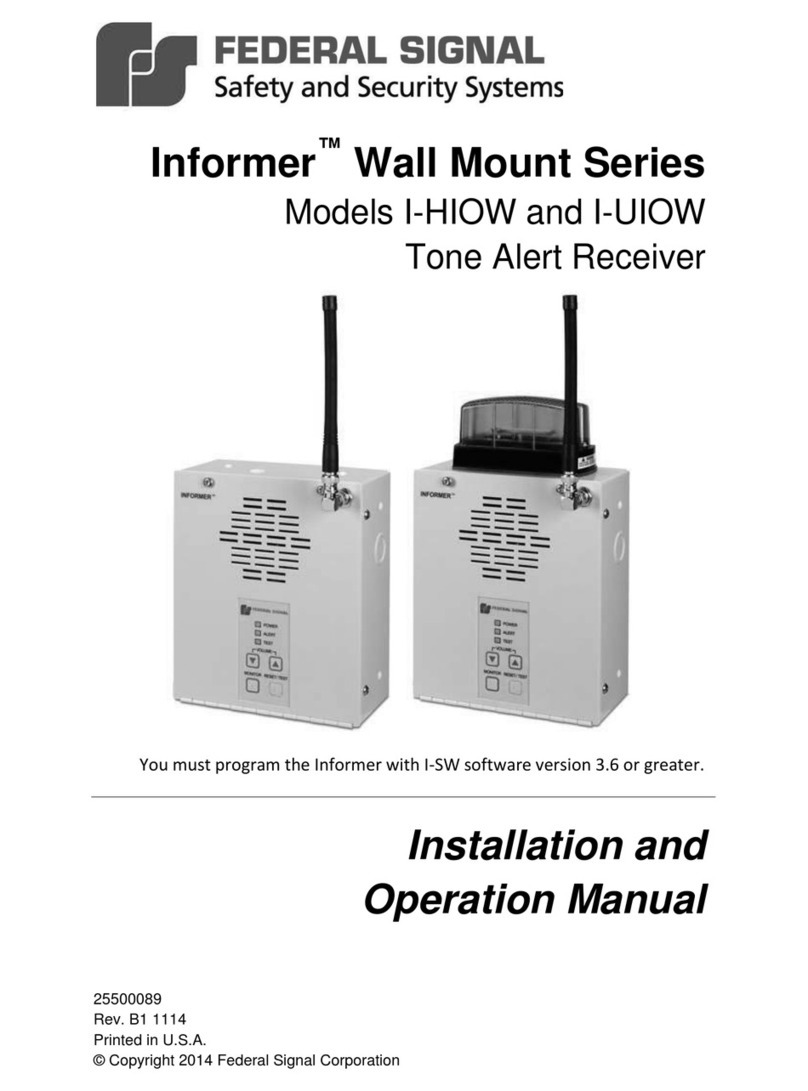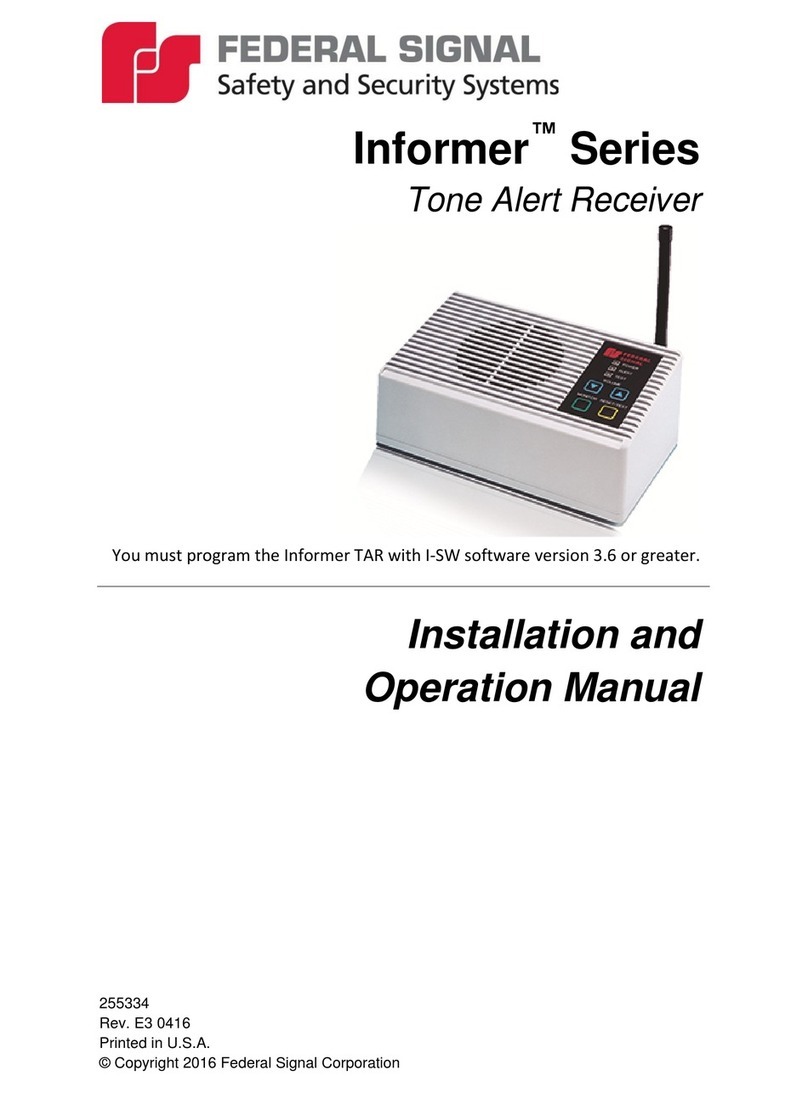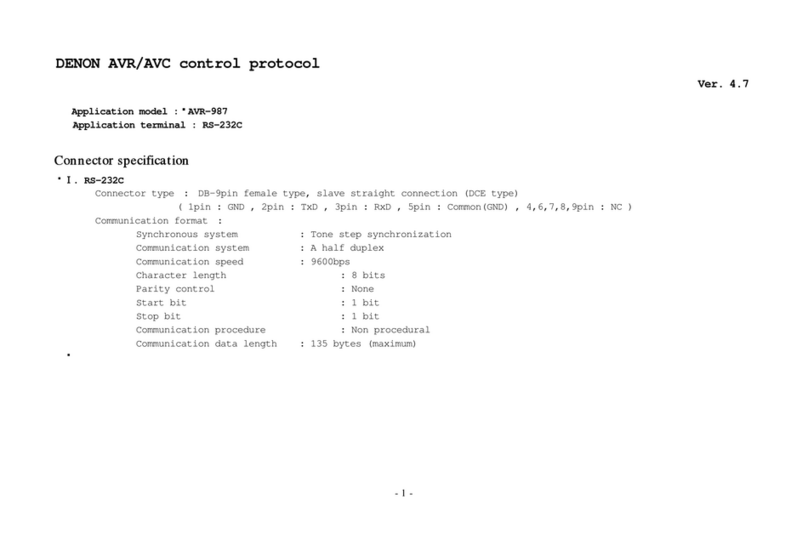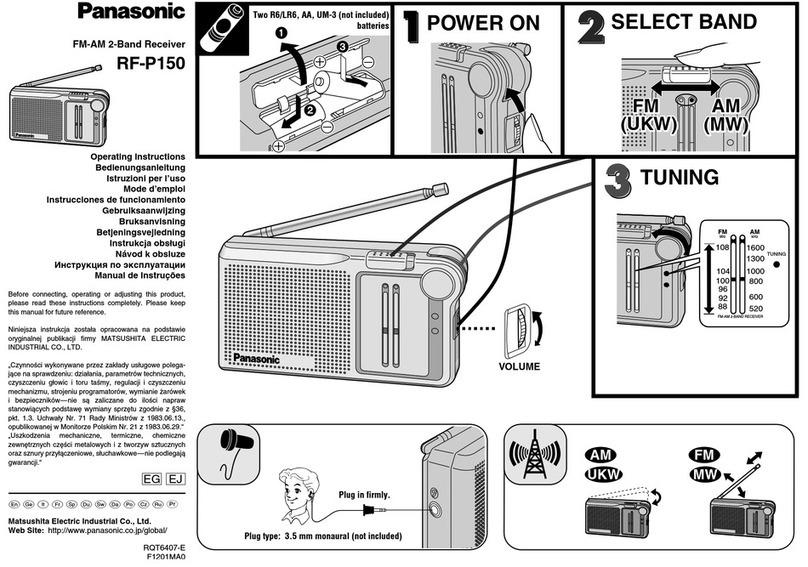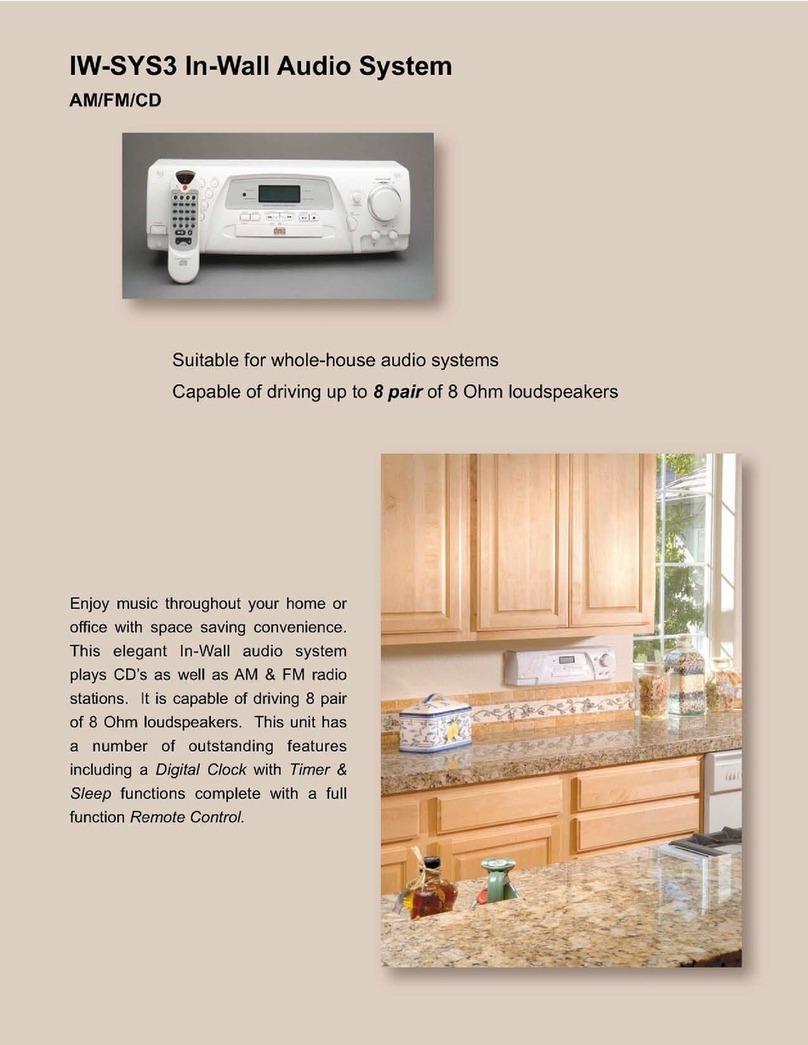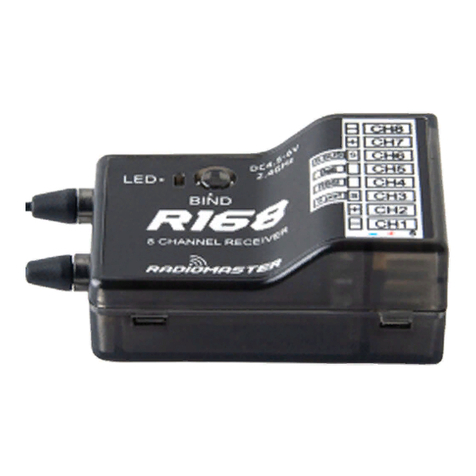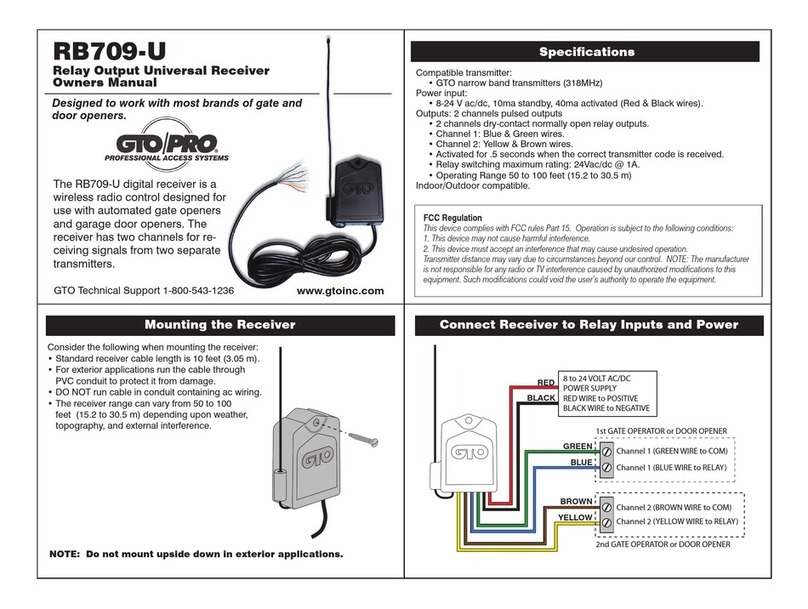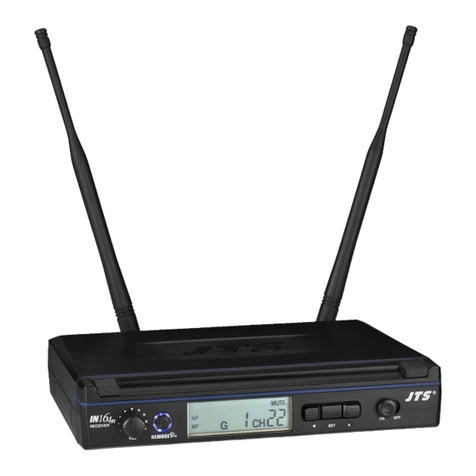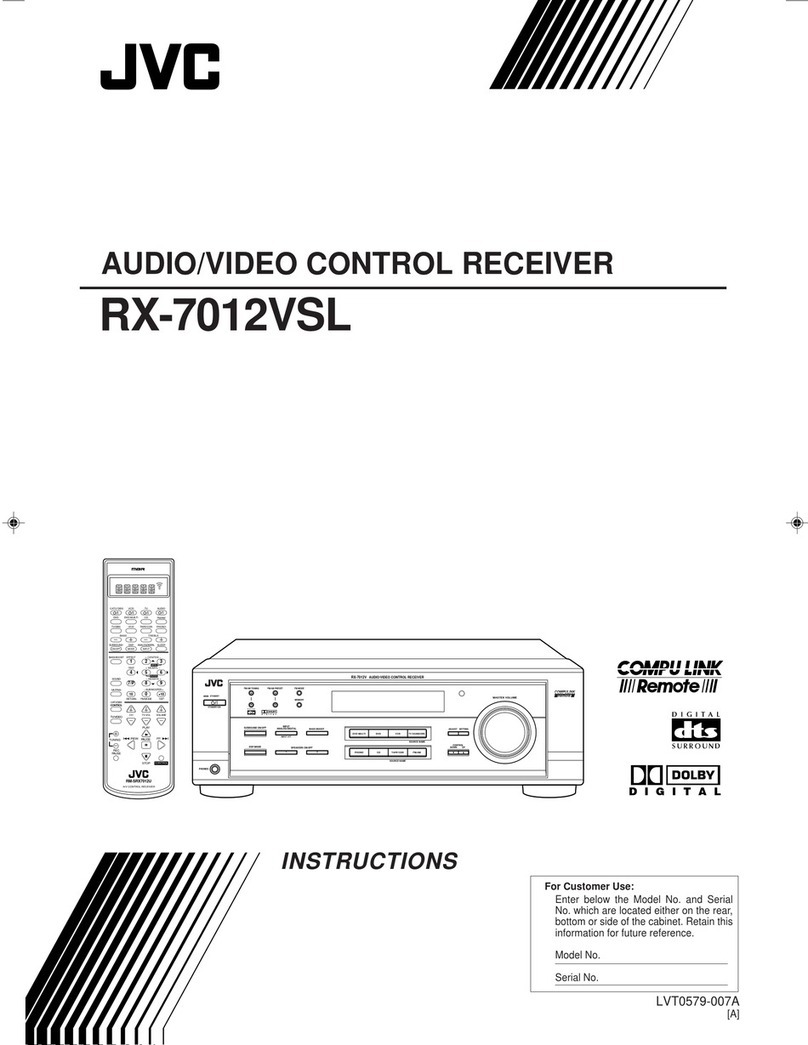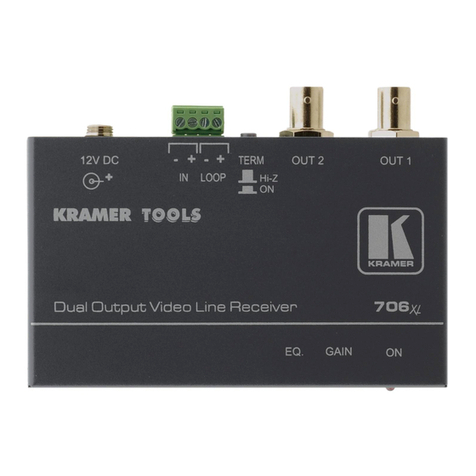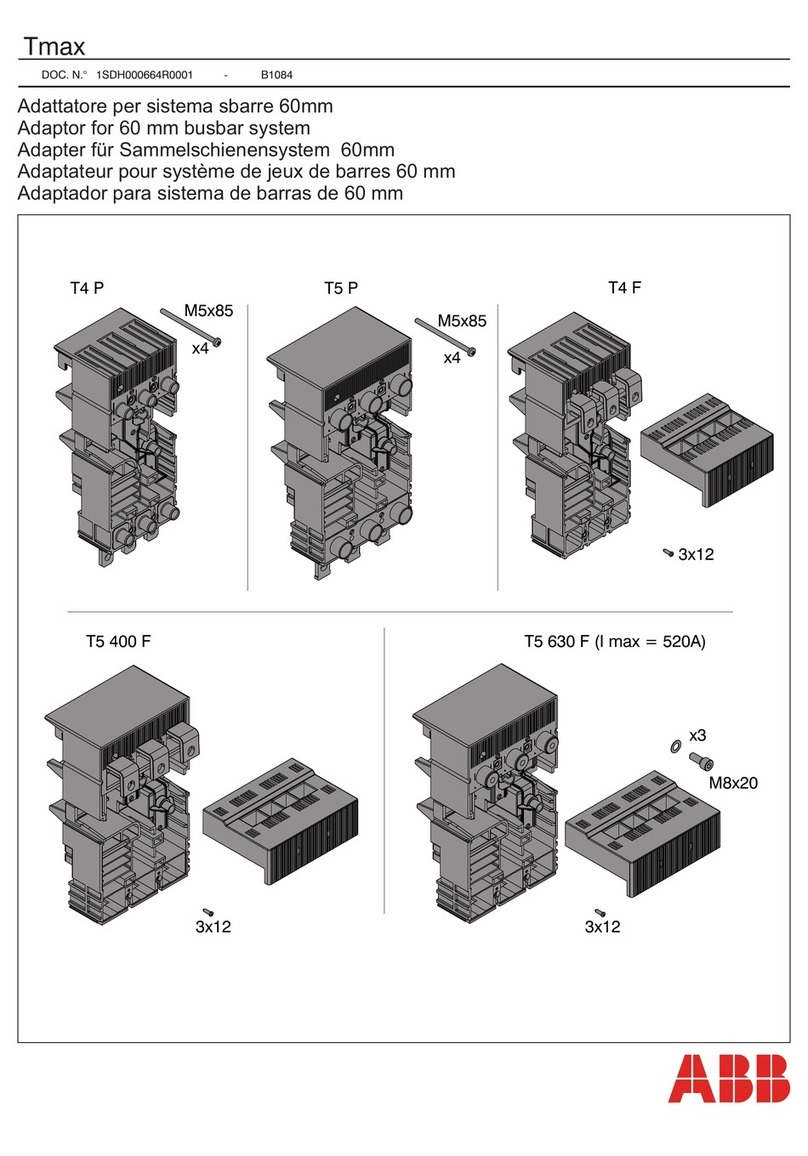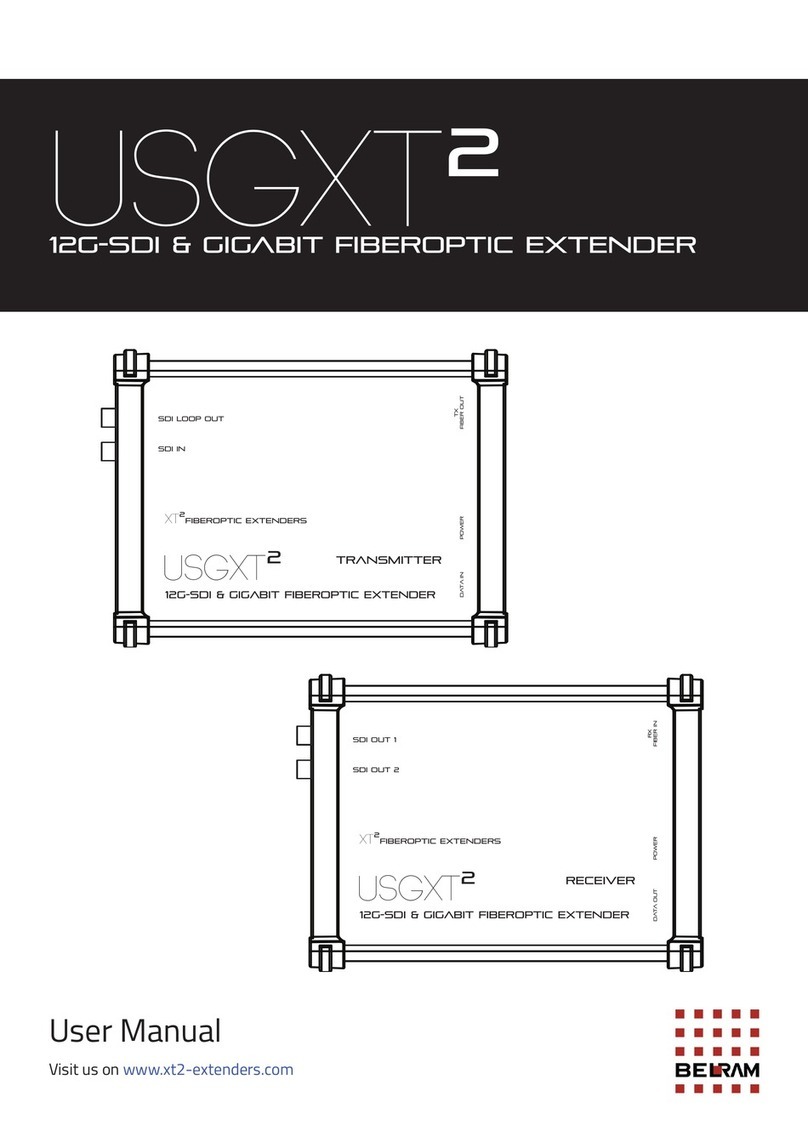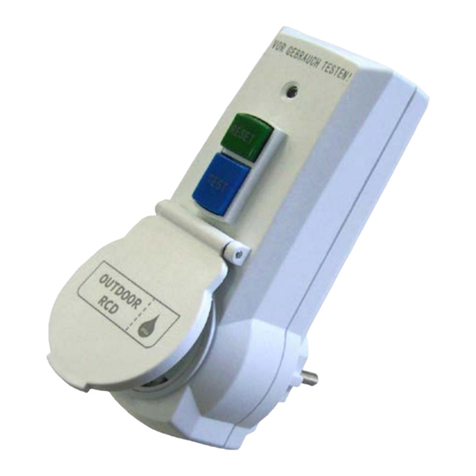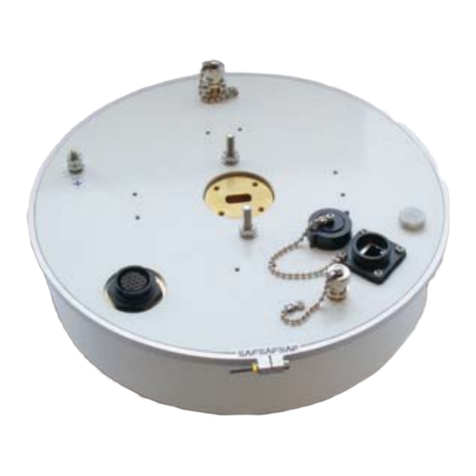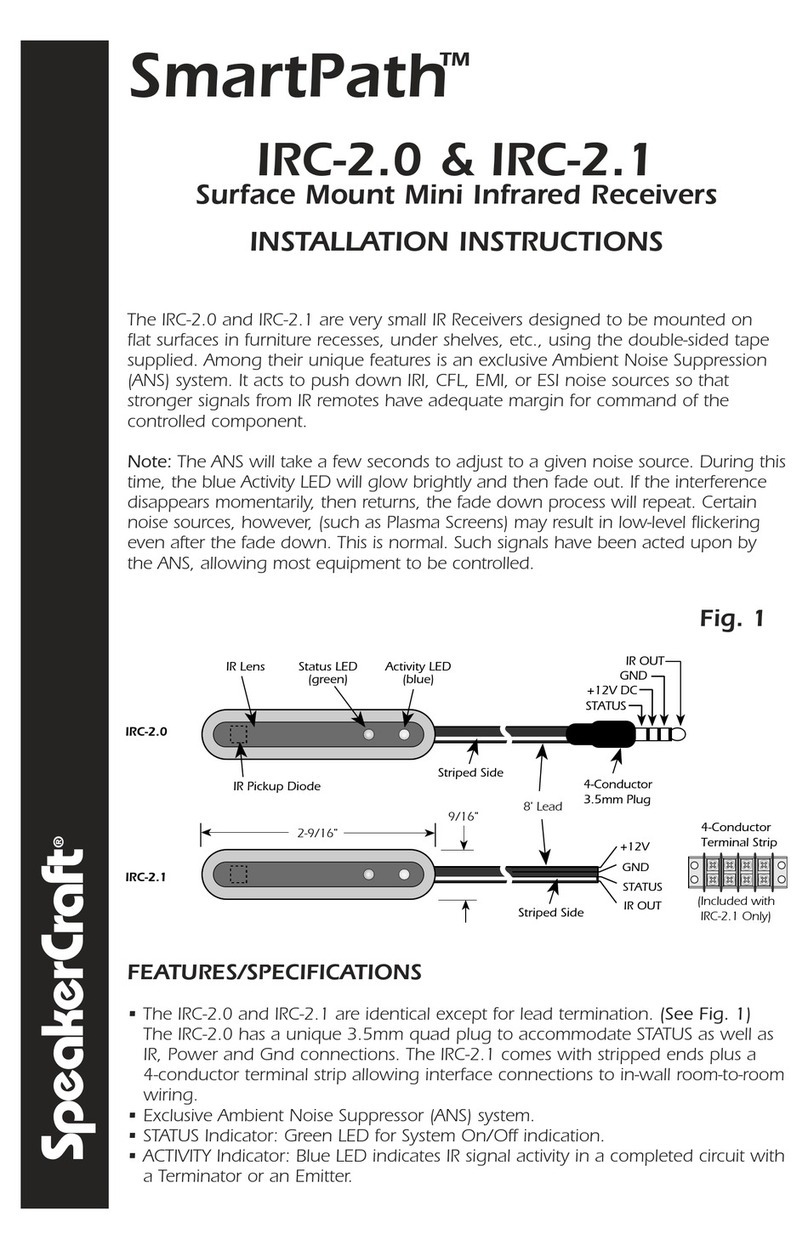Federal Signal Corporation Tone Alert User manual

Informer Series
Tone Alert Receivers
Installation and Operation Manual
Federal Signal Corporation
University Park, IL 60466

Informer Series
Tone Alert Receiver
Installation and Operation Manual
Federal Signal Corporation
2645 Federal Signal Drive
University Park, Illinois 60466
(708) 534-3400
Part No. 255334
Rev. B, 8/2002

Federal Signal Corporation
Informer Tone Alert Receiver Manual
IMPORTANT SAFETY NOTICES
The exclamation point within an equilateral triangle is intended to alert the user to
the presence of important operating and maintenance instructions.
• Read and Follow Instructions - All the safety and operating instructions should
be read before the TAR is operated. Follow all installation, operating, and
use instructions.
• Retain Instructions - The safety and operating instructions should be retained
for future reference.
• Heed Warnings - All warnings on the TAR and in the operating instructions
should be adhered to.
• Installation, Placement and Testing – Proper installation, placement and
testing is required to ensure the unit is able to perform as intended.
Installation, placement and testing should only be performed after the installer
has read and understood this manual. All applicable electrical codes must be
followed.
• Water and Moisture - The TAR should not be used near water - for example,
near a bathtub, washbowl, kitchen sink, laundry tub, in a wet basement, or
near a swimming pool, rain or similar environments.
• Wall Mounting - The TAR should be mounted to a wall only as specified in
this instruction manual.
• Heat - The TAR should be situated away from heat sources such as radiators,
heat registers, stoves, or other accessories that produce heat.
• Power Source - The TAR should be connected to a 9 VDC, 500 mA., Class 2
wall transformer as provided with the unit. Contact your authorized service
center if a replacement is required.
• Power-Cord Protection - Power-supply cords should be routed so that they
are not likely to be walked on or pinched by items placed upon or against
them, paying particular attention to cords at plugs.
• Accessories – Do not exceed maximum accessory relay output rating of 30
VDC, 5 Amps.
i

Federal Signal Corporation
Informer Tone Alert Receiver Manual
• Cleaning - The TAR should be cleaned with a non-abrasive cleaner and a
damp cloth. Do not apply solvents directly onto the TAR.
• Power Lines - An outdoor antenna should be located away from power lines.
• Outdoor Antenna Grounding - If an outside antenna is connected to the
receiver, be sure the antenna system is grounded so as to provide some
protection against voltage surges and built up static charges. Article 810 of
the National Electrical Code, ANSI/NFPA 70, provides information with regard
to proper grounding of the mast and supporting structure, grounding of the
lead-in wire to the antenna-discharge unit, size of grounding conductors,
location of antenna discharge unit, connection to grounding electrodes, and
requirements for the grounding electrode.
• Object and Liquid Entry - Care should be taken so that objects do not fall and
liquids are not spilled into the enclosure through openings.
• Acoustic Output – The sound output of the TAR may cause hearing damage if
the TAR is activated too close to the user. Always keep the TAR at least six
inches away from a listener’s ears whenever the TAR power LED is on or
blinking.
• Damage Requiring Service - The TAR should be serviced by qualified service
personnel when:
1. The power-supply cord has been damaged; or
2. Objects have fallen, or liquid has been spilled into the TAR; or
3. The TAR has been exposed to rain; or
4. The TAR does not appear to operate normally or exhibits a marked
change in performance; or
5. The TAR has been dropped, or the enclosure damaged.
• User servicing should be limited to battery replacement. All other servicing
should be referred to qualified service personnel. Always test the TAR before
using after repairs have been made.
ii

Federal Signal Corporation
Informer Tone Alert Receiver Manual
TABLE OF CONTENTS
SECTION TITLE PAGE NO.
Section I Specifications 1-1
1-1 Electrical 1-1
1-2 Acoustic 1-2
1-3 Dual Relay and 600 ohm Audio 1-3
1-4 Signaling Formats 1-3
1-5 Environmental 1-4
1-6 Physical 1-4
1-7 EMI / RFI 1-4
1-8 Agency Compliance 1-4
Section II General Description 2-1
2-1 General Description 2-1
2-2 Standard Features 2-2
2-3 Optional Features 2-2
2-4 Informer Front Panel Layout 2-3
2-5 Rear View I/O Definitions 2-4
Section III Installation Instructions 3-1
3-1 Warning 3-1
3-2 Determine a Suitable Location 3-1
3-3 Wall Mounting 3-2
3-4 Desk Mounting 3-3
3-5 Optional IO Model Connections 3-3
3-6 Strobe Light Installation 3-4
3-6-1 Model FB2PST-012-024C Strobe 3-4
Light Accessory Installation
3-6-2 Model IS2 Strobe Light Accessory
Installation 3-6
3-7 Testing 3-7
3-8 Training 3-7
iii

Federal Signal Corporation
Informer Tone Alert Receiver Manual
Section IV Operation Instructions 4-1
4-1 General Information 4-1
4-2 Power Supply 4-1
4-3 Monitoring (NOAA Weather Radio 4-1
and Channel Selection)
4-4 Receiving an Alert Message 4-2
4-5 Receiving a Test Message 4-2
4-6 Volume Control 4-3
4-7 Tone-Alert Radio Failure 4-3
Optional Dual Relay and
600 ohm Audio Output 4-3
4-9 Quick Reference Guide 4-4
Section V Service & Maintenance Instructions 5-1
5-1 Battery Replacement 5-1
5-2 Radio Receiver Alignment and
Service 5-1
Section VI Warranty 6-1
iv

Federal Signal Corporation
Informer Tone Alert Receiver Manual
SECTION I
SPECIFICATIONS
1-1 Electrical
• Antenna Impedance 50 Ohms Ohms
• Antenna Type Rubber duck with swivel BNC connector
Frequency Range (MHz)
33 – 50 150 – 17
4
450 - 470 806 – 821 851- 866
Intermodulation Rejection
per EIA-603, part 4.1.9 ≥-67 ≥-70 ≥-62 ≥-55 ≥-55
Adjacent Channel Selectivity
per EIA-603, part 4.1.6
≥-64 ≥-80 ≥-55 ≥-50 ≥-50
Spurious Response
& Image Rejection (dBm)
per EIA-603, part 4.1.8
≥-80 ≥-80 ≥-75 ≥-70 ≥-70
Frequency spread allowable
without re-tuning (MHz) +/-4.9 +/-1.5 +/-10.6 +/-8.5 +/-8.5
• Sensitivity - 12dB SINAD ≤.35 µfor 12dB SINAD per EIA-603, part 4.1.4
• Decode Sensitivity ≤0.5 µV
• Operating Current < 100 mA. Standby
<400 mA. Max.
• Battery Capacity Internal sealed Lead-Acid, capable of
running for 6 hours in standby mode w/
15 minutes of each hour generating
siren beep audio at rated audio output,
(Based on Pulsed Tone audio).
Low voltage cutoff set to 5.38 VDC +/-
0.1 VDC.
• Operating Voltage 8 to 15 VDC, Unit supplied with a 9
VDC, 500 mA. power supply with a 120
VAC, 60 Hz primary Center terminal is
positive (+) on the DC connector.
• Hum and Noise -37dB when unsquelched, -57dB
squelched relative to full quieting signal
w/ 1 kHz tone @ 3 kHz deviation @
rated audio out per EIA-603, part 4.1.11
1-1
SPECIFICATIONS

Federal Signal Corporation
Informer Tone Alert Receiver Manual
• Audio Output 1 Watt into 8 ohms
• Audio Distortion < 5% @ 85dB output, w/1 kHz tone.
• Audio Sensitivity ≤30% of nominal system deviation,
1.5 kHz minimum deviation to produce
85dB audio output level w/ volume
control @ full per EIA-603, part 4.1.1.7)
1-2 Acoustic
• Message Audio Output Message Audio variable from 50dBA to
85dBA @ 10’ from the speaker on axis
User cannot disable Alert or message
audio.
• Alert Beep Audio Steady Tone = 1000Hz
Pulsing Tone=1000Hz pulsed 100ms
ON, 100ms OFF
Alternating Tone (Hi-Lo) = Alternating
between 1000Hz and 500Hz tones.
Each pulse lasts 100ms.
Sweeping Tone (Warble) = 500Hz
rapidly ramped to 1000Hz
Overall lengths are programmable.
Alert Beep Audio fixed @ 85dBA min.
(not adjustable) @10’ from speaker.
1-2
SPECIFICATIONS

Federal Signal Corporation
Informer Tone Alert Receiver Manual
1-3 Dual Relay and 600 ohm Audio Two SPDT Relay Outputs,
Output (IO Option) 5 amps @ 30VDC
Relay outputs can be programmed to cycle on & off, or come on
continuously with the on-time, off-time, and total-time being
programmable.
Once activated, the relay outputs can be programmed to be reset
manually, reset after a programmable number of seconds or reset after a
programmable number seconds after the carrier drops.
The 600 Ohm audio output will respond as the speaker does, coming on
with the speaker and being reset or shutting off with the speaker. Its
output level is adjustable from 0 to 2.5Vp-p into 600 Ohms w/ 1kHz tone
@ 3kHz deviation.
1-4 Signaling Formats
• Number of codes Up to 6 programmable activation
codes max
• Two-Tone Sequential & 300Hz - 3000Hz
Single Tone tolerance +/-1.5%
Minimum tone spacing = 5%
Minimum “A” tone length = .5 sec
minimum “B” tone length = .25
sec minimum.
8 sec. maximum for all tones
Decode Sensitivity </=20dB SINAD
• DTMF 1-12 digits maximum,
minimum character length =
50ms. (35ms as special)
Characters plus inter-character
spacing not to exceed 1000ms.
DTMF Decode Sensitivity </= 20dB SINAD
• Optional MSK Decoder 1200,N,8,1, Synchronous
1200 Hz mark tone, 1800 Hz
space tone.
MSK Decode Sensitivity </=12dB SINAD
1-3
SPECIFICATIONS

Federal Signal Corporation
Informer Tone Alert Receiver Manual
• Optional EAS/SAME Decoder 520.83(6250/12)bits per second,
2083.3Hz Mark tone. 1562.5Hz
Space tone, no Start, Stop, or
Parity bits. 7 bit ASCII, + 8th
null bit (either 1 or 0), LSB sent
first
EAS Decode Sensitivity </= 18dB SINAD.
• CTCSS/CDCSS (PL)
A different PL code can be programmed for each RF freq. Decodes
with Two-Tone codes >/= 400Hz only. Tone Frequency Range 36.6 to
254.1Hz
Tone Accuracy > .05 Hz
Tone Decode Bandwidth +/- 1.1%
Digital, Golay (23,12) 23 bit digital word
Digital Data Rate 134.4 Hz nominal
Decode Turn on Time < 250ms.
Decode Turn off Time < 1.2s.
Number of codes 60 - Tone, 83 Digital
PL Decode Sensitivity </= 12dB SINAD
1-5 Environmental
• Temp Range -30 to +60C.
• Humidity Range 0-98%, non-condensing
1-6 Physical
• Size 3.325” x 8.69”x 5.0”(HxWxD)
• Weight 2.5 lbs.
• Color PANTONE 421U
• Material Textured ABS Plastic
1-7 EMI / RFI
Complies with FCC
Title 47
,
Part 15
1-8 Agency Compliance Complies with UL 1270
1-4
SPECIFICATIONS

Federal Signal Corporation
Informer Tone Alert Receiver Manual
SECTION II
GENERAL DESCRIPTION
2-1 General Description
The Federal Signal Informer Tone Alert Receiver (TAR) is a significant innovation
in emergency alerting. The TAR is the first unit of its type available in all
commercial FM bands from 33 – 866 MHz. It is also the first TAR capable of
decoding multiple formats (single-tone, two-tone, DTMF and optionally EAS or
Federal Digital) at the same time. These features enable the Informer to be
easily integrated into virtually any new or existing warning system.
The TAR is a robust radio receiver with a loud speaker output designed
specifically for warning applications. The unit can be wall mounted or sit on a
desktop and comes with an attached antenna that can be removed for
connection to an outside antenna. The TAR has a built-in battery and charger to
provide reliable operation even in the event of an AC power failure.
The Informer can be pre-programmed with up to four separate warning tones
plus a channel monitor function for live PA announcements. Two optional
programmable relay outputs and a 600-ohm audio output are also available.
These outputs can be used to control other equipment such as an optional strobe
light for warning the hearing impaired and to tie into external PA systems
respectively.
Up to four separate RF channels may be programmed into the TAR. The
channels are easily selected from the built in membrane keypad. Each of the RF
frequencies must be within the allowable frequency spread for the RF band being
used (see specifications section above). The receiver must be re-tuned if the RF
frequency is changed outside of the allowable frequency spread range within the
respective band. Contact an authorized Federal Signal dealer or service center if
tuning is required.
The Informer is completely programmable over a built in RS232 port from an
easy to use Windows 95/98® based software program. All data is stored in non-
volatile FLASH and EE memory. Using this technology, both the application
software and the user specific configuration data can be updated over the serial
port without the need to disassemble the unit and burn IC chips.
The Informer series receivers meet all requirements defined by the Federal
Emergency Management Agency for the CSEPP programs.
2-1
GENERAL DESCRIPTION

Federal Signal Corporation
Informer Tone Alert Receiver Manual
2-2 Standard Features
• Available in 5 frequency bands from 33 MHz to 866 MHz
• Long life rechargeable battery with built-in charger
• Wide temperature operating range
• Excellent RF sensitivity, and selectivity
• Clean, low distortion of recovered audio
• Loud +85dBA output at 10’
• Signal to Noise based squelch circuit, does not open receiver in high radio
noise environments i.e., near computers etc.
• Programmable RF, Single Tone, Two-Tone, DTMF, CTCSS, and CDCSS
(DPL) decoding
• Re-programmable over RS232 port without removing IC chips
• Volume control, monitor and reset buttons with diagnostic LEDs
2-3 Optional Features
• Programmable MSK decoder compatible with The Federal
Commander Digital System.
• Programmable EAS decoder for decoding NOAA radio SAME code
alerts.
• 600-Ohm audio output and 2 SPDT relay outputs.
• Windows 95/98® based programming software
• IS2 and FB2 Strobe Light Accessories
Note: The MSK and EAS decoders are not available simultaneously in the same
unit. All other options can be used together.
2-2
GENERAL DESCRIPTION

Federal Signal Corporation
Informer Tone Alert Receiver Manual
2-4 Informer Front Panel Layout
Speaker Keypad BNC Antenna Connector
MONITOR
VOLUME
ALERT
RESET/TEST
TEST
FEDERAL
POWER
SIGNAL
2-3
GENERAL DESCRIPTION

Federal Signal Corporation
Informer Tone Alert Receiver Manual
2-5 Rear View I/O Definitions
BNC Antenna Power Input Audio Output Level
Connector Adjustment (Optional)
600 ohm Audio
Squelch Not Used & Relay Outputs
(Optional)
Wall Mount Keyholes Battery Switch
Programming Port
OFF ON
2-4
GENERAL DESCRIPTION

Federal Signal Corporation
Informer Tone Alert Receiver Manual
SECTION III
INSTALLATION INSTRUCTIONS
3-1 Warning
Read and adhere to all safety warnings beginning at page “i” of this
manual before installing the Informer.
3-2 Determine a Suitable Location
When picking a location for the Informer TAR, first consider the following
criteria:
1. The TAR contains a radio receiver that should be placed as far as
possible from electrically noisy electronic devices to avoid interference
and enable the desired RF signal to be received. Examples of noisy
devices may include microwave ovens, motor driven devices, light
ballasts, and electrical switching devices.
2. Conductive building materials can block radio waves from reaching the
TAR. In some areas, a larger antenna or an external antenna which
provides more signal may be required. Radio reception can be
monitored by holding down the Monitor button until audio is heard from
the speaker (if the monitor function has been programmed into the
TAR). The clarity of speech should be monitored to ensure it is clear
and intelligible and does not cut in and out. The unit should also be
activated from the TAR control station to verify it is programmed
correctly and is receiving the control signals.
3. The TAR should be positioned to keep the unit at least six inches away
from the listener’s ears to avoid potential hearing damage.
4. The TAR should be placed in an area where the speaker can be heard
when the TAR is activated. The level of the warning tone can be
checked by holding down the MONITOR & RESET buttons together
until the Alert beeps are heard. If the coverage area is large, multiple
TARS’ or external amplifiers and speakers may be required to provide
adequate warning.
5. The TAR should not be used near water - for example, near a bathtub,
washbowl, kitchen sink, laundry tub, in a wet basement, near a
swimming pool, rain or similar environments.
3-1
INSTALLATION INSTRUCTIONS

Federal Signal Corporation
Informer Tone Alert Receiver Manual
6. The TAR should be located within six feet of an AC power receptacle
to eliminate the need for an extension cord.
7. The TAR should be placed where it will not be inadvertently covered or
moved. A permanent wall mounting is recommended after a suitable
location has been found.
3-3 Wall Mounting
Wall mounting is the preferred mounting method for the Informer TAR.
Before mounting the TAR, determine a suitable location considering the
criteria listed above. The TAR has two keyholes located on the bottom of
the unit that will accept #8 screws. The mounting screws should be
placed horizontally level, approximately 6” above eye level and 4” apart on
center. Ensure the screws are placed into material that can adequately
support the weight of the TAR. Use a #8 wall anchor when mounting to
drywall. Ensure that the screws are tightened sufficiently to securely
fasten the TAR against the wall.
The local rubber antenna should be mounted vertically on top of the TAR
(not bent at 90°) such that the antenna is pointed toward the ceiling. If an
external antenna is required, it should be installed by a qualified electrician
in accordance with local and national electrical codes.
The 9 VDC power supply should be run against the wall and plugged into
a 120 VAC, 60 Hz outlet. Plug the low voltage end of the cord into the
power jack located at the rear of the TAR. The cord should be routed to
ensure it is protected against walking on, tripping over or pinching the
cord. Turn the battery switch to the on position (see section 3-7).
3-2
INSTALLATION INSTRUCTIONS

Federal Signal Corporation
Informer Tone Alert Receiver Manual
3-4 Desk Mounting
Before putting the TAR in place, determine a suitable location considering
the criteria listed above. It is recommended to use the wall mounting
method if the optional strobe light accessory is used. The local rubber
antenna should be bent at 90° so the antenna points toward the ceiling. If
an external antenna is required it should be installed by a qualified
electrician in accordance with local and national electrical codes.
The 9 VDC power supply should be run against the wall and plugged into
a 120 VAC, 60 Hz outlet. Make sure the cable is protected against
walking on, tripping over or pinching the cord. Plug the low voltage end of
the cord into the power jack located at the rear of the TAR. Turn the
battery switch to the on position (see section 3-7).
3-5 Optional IO Model Connections
Do not exceed the electrical ratings defined in the
specifications for the IO option.
If one of the IO models of the Informer is purchased, a 600-ohm balanced
audio output and two SPDT relay outputs are available. A removable 8
position connector is located on the back side of the Informer for making
electrical connections. The connector accepts 5mm (3/16”) stripped wire,
18 – 26 AWG.
Make electrical connections to the I/O connector as follows:
Pin No.1
PIN DESCRIPTION
1 Audio Output
2 Audio Output
3 Relay 1 N.O. Contact
4 Relay 1 Common
5 Relay 1 N.C. Contact
6 Relay 2 N.O. Contact
7 Relay 2 Common
8 Relay 2 N.C. Contact
Audio Output Level Adjustment Potentiometer
3-3
INSTALLATION INSTRUCTIONS

Federal Signal Corporation
Informer Tone Alert Receiver Manual
3-6 Strobe Light Installation
The optional strobe light accessories enable the TAR to provide warning
to the hearing impaired and users in high ambient noise areas. To use a
strobe light accessory, an IO model of the Informer is required to provide
the necessary relay output for controlling the strobe. The strobe light
accessory also requires a second 120 VAC, 60 Hz outlet.
This accessory must be installed per local and national
electrical codes by a qualified electrician.
3-6-1 Model FB2PST-012-024C Strobe Light Accessory Installation
Install the strobe on the wall near the TAR at least 24” below the ceiling
per instructions provided with the unit. Install the model PS250 power
supply on the wall near the strobe and TAR per instructions provided with
the unit. Make electrical connections to the strobe, power supply and TAR
as shown in the following diagram. The connection between the TAR and
the strobe requires an 18 AWG two-wire cable with 5mm (3/16”) stripped
wire on the TAR end and 5/16” stripped wire on the other. Make all other
connections before connecting power. Connect the batteries first, and
then AC power, after all other connections have been made.
Refer to the wiring diagram on the following page.
3-4
INSTALLATION INSTRUCTIONS

Federal Signal Corporation
Informer Tone Alert Receiver Manual
Model FB2PST-012-024C Strobe Light Accessory Wiring Diagram
3-5
INSTALLATION INSTRUCTIONS

Federal Signal Corporation
Informer Tone Alert Receiver Manual
3-6-2 Model IS2 Strobe Light Accessory Installation
Install the model IS2 strobe vertically, near the TAR, at least 24” below the
ceiling. The connection between the TAR and the strobe requires a user
supplied 18-20 AWG two-wire cable with 5mm (3/16”) stripped on the TAR
end and ¼” quick connects on the other. The quick connects must be
installed after running the wires into the strobe box to enable the wire to
pass through the strain relief. There is no polarity for these strobe
connections.
Make electrical connections to the strobe, and TAR as shown in the
following diagram.
Model IS2 Strobe Light Accessory Wiring Diagram
3-6
INSTALLATION INSTRUCTIONS
This manual suits for next models
1
Table of contents
Other Federal Signal Corporation Receiver manuals
